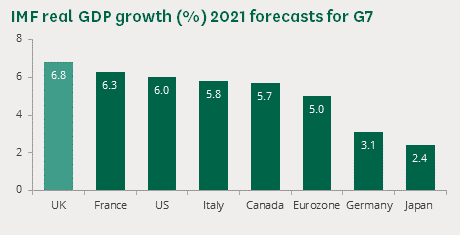Looking forward to 2022 with Covid still creating uncertainty
With Christmas fast approaching we will all be looking forward to a break and the New Year. Recent months have seen an acceleration in business activity which has led to a further drop in unemployment as well as sudden shortages as the growth has in some cases outpaced the ability of supply chains to boost capacity. The IMF and OECD both have very similar GDP growth forecasts for 2021 as published recently in a briefing for UK Parliament.
And when one considers that during the first quarter of 2021 we were still in a GDP contraction trend it makes this result even more impressive.


The momentum of this growth in economic activity is creating its own challenges and opportunities such as:
Supply Chain challenges resulting in shortages
We’ve seen this already with recent shortages of some goods in supermarkets. As difficult as an unexpected shortfall in supply may be, businesses can be ready for these shocks by a combination of:
- More thorough long-term planning that looks at the change in trends and puts in place orders ahead of the demand
- Streamlined short-term processes are akin to crisis management which looks at resolving current shortfalls as quickly as possible.
Having people that can reshape these processes and put in place the right triggers for adjusting order requirements at the right time is part of the solution.
Resource shortages impacting service
Again we’ve seen this already with haulage driver shortages impacting the availability of fuel at pumps. These shortages are created by the shape of the recovery being both steeper than what we have been used to in the past (with the exception of the BRICs), and taking a different shape to what we had before with a greater demand for some skills in particular than is available in the market. For example, with increased remote working, there is a greater drive for solutions in the Cloud and therefore associated skills.
However, there is another factor which I touched upon in June Changing working environments on mental health where 74% of respondents did not want to return to the office full time and a trend of people choosing alternative work to what they have done before in order to secure the lifestyle benefits some got accustomed to during lockdown.
This has changed the shape of the available workforce. Labour shortages can be good for employees as this drives wage growth but just upping wages is a recipe that doesn’t work in the long term as organisations will naturally have to control long-term costs. In any case, just throwing money at a problem doesn’t solve things as we saw with the haulage driver shortage. Attracting people to join and to retain them because of a wider set of benefits that gives people the security and lifestyle preferences they have becomes more important and ultimately is the most cost-effective way forward.
Standing out
As demand is returning and having had a break from past habits, customers are now more open to looking at alternatives. This is a great opportunity for business. And when customers are looking the ability of an organisation and a brand to stand out becomes more important. Innovative ways of presenting services and products to customers that delight the customer experience will be the winners.
And with a return of positive cashflows, this is the time to invest in standing out. I have a great local example of a coffee shop that opened up during lockdown. The way they set up the coffee shop, the offering they have, the initial marketing and promotions they did, and the atmosphere they have created, means that though new they are now one of the most popular. Other recent openings are not proving to be as successful. Even of familiar and popular brands, mainly because the offering is more of the same…
However, we are not out of the Covid-19 woods yet, as the recent omicron variant has highlighted to us all. So the good practice of weathering stormy economic environments still hold true:
Analyse the risks and respond to them
Start with the familiar SWOT analysis to work out the current position of your business, organising information in terms of consequences, not causes. Ask those difficult questions such as, “Who we are? What do we do? What do we do well, what not so well ?”. Define the response in terms of
-
- What is needed to survive the storm and what is needed to secure the future after the storm.
- The Impact on Employees, Customers and Partners.
- What opportunities can be capitalised on to secure growth.
Business Continuity and Rebuilding for the future
Continuously review and rebalance your investment. Some projects may no longer make financial sense, and other new initiatives may make more sense. In these circumstances, there are four key ingredients the organisation needs to have in place:
-
-
- Be Agile and accept uncertainty: Act like a start-up company, avoid analysis paralysis, remember the Pareto principle of 80/20, prioritise your requirements and be honest with everyone that plans may need to change.
- Use high-performing programme teams: Makes sure you bring in teams that know how to deliver and deliver well, not as individuals, but as a team that works well together. For more detail, see our separate content on what makes a high-performing team.
- Work with speed and control: The perennial challenge for businesses is how to deliver change at speed without losing control. The right controls focus on the key triggers not all the detail – detail results in decisions taking weeks and months.
- Make timely decisions and investment: A wrong decision made early gives an opportunity for correction but the right decision made late means the opportunity may well have been lost. To achieve this requires streamlined governance.
-
Manage and Monitor
Test, review and closely monitor the outcomes ensuring the plan meets the evolving needs of the business. Things that work well and things that don’t need to be identified quickly. This is then fed back to the analysis stage allowing your plan to be refined and kept relevant.
Some of the challenges we will face in 2022 may be new. But a focus on people and the usual best practice is part of the answer.
And on that note, I’d like to wish everyone a healthy, happy and prosperous 2022!







